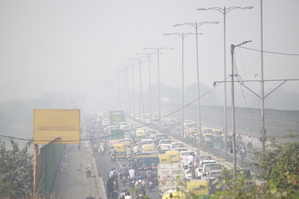Headlines
Delhi-NCR grapples with pollution as air quality dips

New Delhi, Nov 12
Delhi-NCR continues to grapple with hazardous air quality levels, with the average Air Quality Index (AQI) remaining at 355, classified as 'very poor.'
According to the Central Pollution Control Board (CPCB), Delhi's AQI at 7:30 A.M. on Tuesday was 355, while surrounding NCR cities also recorded high AQI levels: Haryana's Faridabad was at 205, Gurugram at 234, while Uttar Pradesh's Ghaziabad was at 269, Greater Noida at 286, and Noida at 235.
Several areas in Delhi recorded AQI levels above 400, categorising them as 'severe,' including Anand Vihar (404), Jahangirpuri (418), Mundka (406), Rohini (415), and Wazirpur (424).
Many other areas reported AQI readings between 300 and 400, indicating persistent poor air quality across the city, including Alipur (358), Ashok Vihar (391), Aya Nagar (347), Bawana (393), and Punjabi Bagh (382).
The CPCB classifies AQI levels as follows: 'good' (0-50), 'satisfactory' (51-100), 'moderate' (101-200), 'poor' (201-300), 'very poor' (301-400), and 'severe' (401-450), with any reading above 450 deemed 'severe plus.'
In response to escalating pollution, the Commission for Air Quality Management (CAQM) has implemented a series of mitigation measures, including the Graded Response Action Plan (GRAP).
Enforcement of stricter penalties on polluting construction sites, vehicles, and industries is underway. Additionally, efforts to control road dust are being bolstered by deploying over 600 mechanical road-sweeping machines, water sprinklers, and anti-smog guns throughout the NCR.
The Aam Aadmi Party (AAP)-led Delhi government launched a month-long anti-open burning campaign on November 6 as part of its Winter Action Plan.
Environment Minister Gopal Rai announced the decision after a review meeting, aiming to reduce air pollution with help from 588 patrolling teams. These teams will monitor construction sites, discourage stubble burning, and create awareness among farmers.
The 21-point Winter Action Plan, an expansion of last year's 14-point strategy, also includes initiatives like drone surveillance, anti-dust campaigns, and road-sweeping machines.
Additionally, Resident Welfare Associations, construction agencies, and government departments have been advised to supply electric heaters to security guards to prevent open burning for warmth.
The Delhi government has also requested neighbouring states, including Uttar Pradesh and Haryana, to intensify their pollution control efforts, emphasising that combined regional actions can lead to a stronger impact on air quality improvement.



































